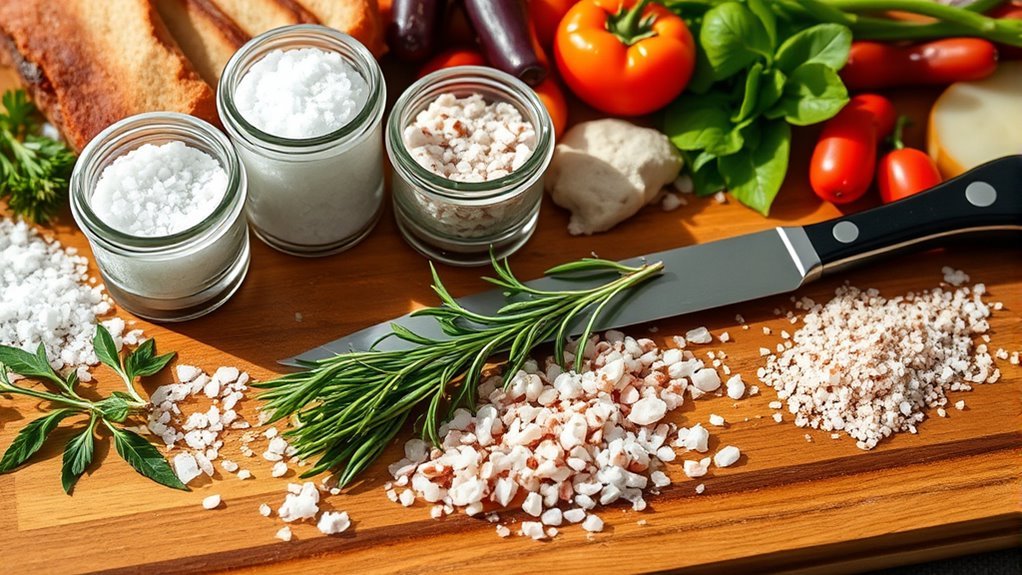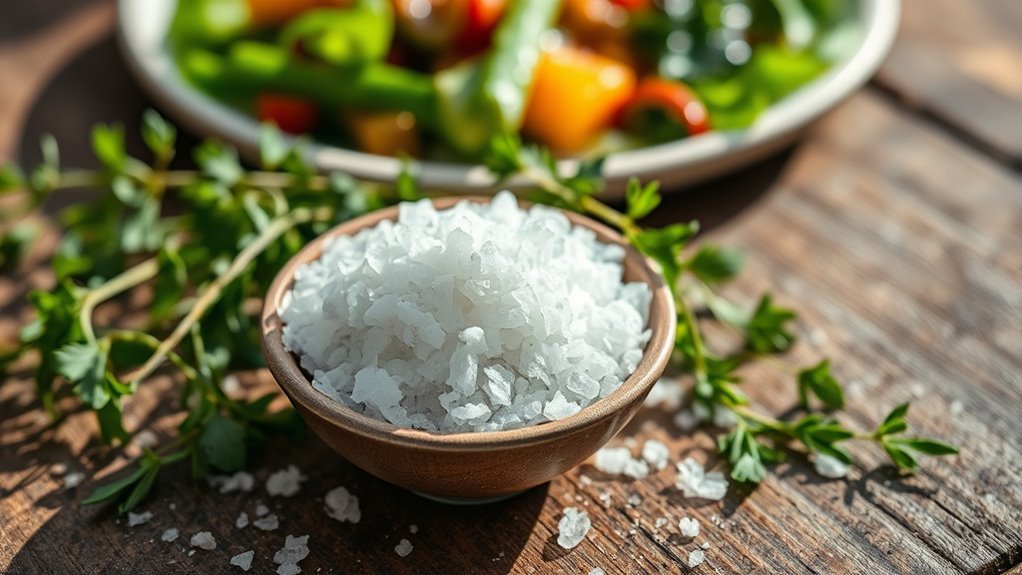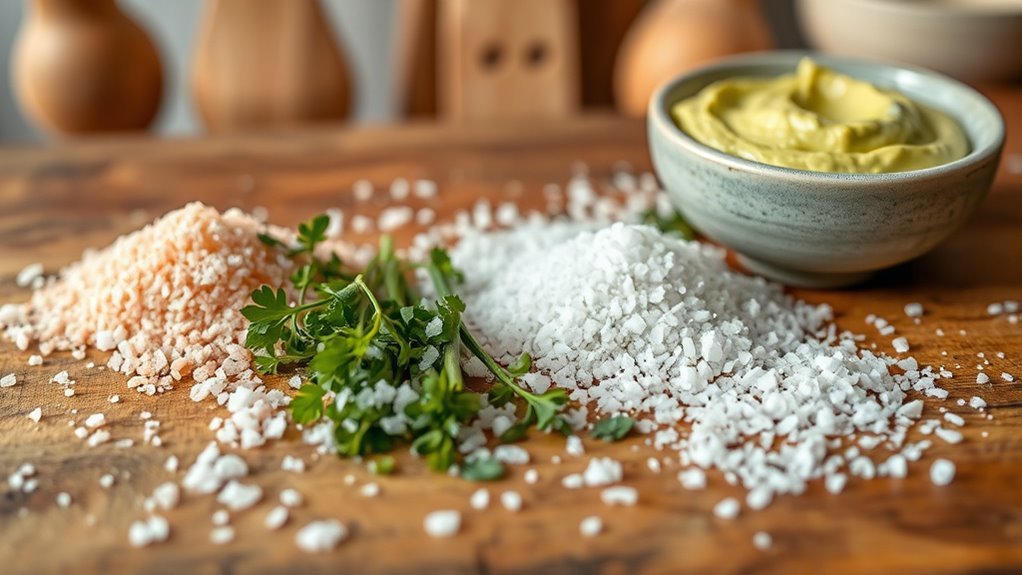Absolutely, you can have salt on a keto diet, and it’s essential for maintaining your electrolyte balance. As your body adapts to ketosis, sodium needs actually increase due to its excretion in response to lower insulin levels. Consuming between 3,000 to 5,000 milligrams of sodium daily can help prevent symptoms of the “keto flu,” such as fatigue and cramps. Sources like sea salt and broth are great choices. Interested in learning how to effectively balance your sodium with other electrolytes?
Understanding the Role of Sodium in the Body

While you might think of sodium primarily as a seasoning, it actually plays an essential role in your body’s overall function. Sodium is a key electrolyte, important for maintaining fluid balance and supporting nerve function. It helps regulate blood pressure and volume, ensuring that your cells receive the nutrients they need. Without adequate sodium, your body can experience muscle cramps, dizziness, and fatigue. The sodium function is particularly important during activities like exercise, where you lose electrolytes through sweat. It’s crucial to understand that while sodium is necessary, moderation is key to avoid potential health issues. Embracing this understanding empowers you to make informed choices about your diet, especially in a keto lifestyle, where electrolyte management becomes even more significant.
The Importance of Electrolyte Balance on Keto

Maintaining electrolyte balance is essential when you’re following a keto diet, as the shift in your body’s metabolism can lead to increased excretion of electrolytes, particularly sodium, potassium, and magnesium. This electrolyte depletion can result in symptoms like fatigue, muscle cramps, and headaches, which can hinder your keto journey. Ensuring adequate sodium absorption helps to mitigate these effects, as sodium plays a vital role in maintaining hydration and nerve function. To support your overall well-being on keto, consider incorporating electrolyte-rich foods or supplements into your routine. By prioritizing electrolyte balance, you empower yourself to navigate the diet’s challenges confidently, enjoying the freedom that comes with better energy levels and overall health.
How Keto Affects Your Sodium Levels

As your body adapts to the ketogenic diet, it undergoes significant metabolic changes that can directly impact your sodium levels. Many people experience a condition known as “keto flu,” which can lead to decreased sodium retention. This happens because reducing carbs often results in lower insulin levels, promoting sodium excretion. Here are some key considerations regarding sodium on keto:
- Increased sodium needs due to lower retention
- Potential for dehydration if sodium levels drop
- Symptoms of keto flu may include fatigue and headaches
- Importance of monitoring sodium alongside other electrolytes
Maintaining adequate sodium levels is essential for your overall well-being on keto. Don’t hesitate to adjust your salt intake as your body shifts to this new metabolic state!
Common Misconceptions About Salt and Keto
Have you ever wondered if salt is a friend or foe on a ketogenic diet? Many salt myths suggest that all sodium is harmful, but that’s not the whole truth. In fact, sodium is essential for maintaining electrolyte balance, especially on keto. While some people worry about high blood pressure, the key is moderation and choosing the right sodium sources. Natural salts like sea salt or Himalayan salt offer trace minerals beneficial for your health. It’s also important to remember that a low-carb diet may require increased salt intake due to reduced insulin levels, which can lead to sodium loss. So, don’t shy away from seasoning your meals—just be mindful of your overall sodium consumption and listen to your body’s needs.
Recommended Sodium Intake for Keto Followers
While the amount of sodium you should consume on a ketogenic diet can vary based on individual needs, most experts recommend aiming for a daily intake of about 3,000 to 5,000 milligrams. This range can help you maintain electrolyte balance and support your body’s unique functions.
Here are some great sodium sources to take into account:
- Sea salt or Himalayan salt
- Broth or bone broth
- Pickled vegetables
- Olives or capers
Incorporating these sodium sources not only enhances flavor but also provides essential sodium benefits, such as reducing the risk of keto flu and promoting hydration. Remember, listen to your body and adjust your intake as needed to find what works best for you on your keto journey.
Benefits of Adding Salt to Your Keto Diet
Adding salt to your keto diet can greatly enhance your electrolyte balance, which is essential for maintaining proper bodily functions. It also plays an important role in supporting hydration levels, helping you avoid some common issues like fatigue and dizziness often associated with low-carb diets. By ensuring you get enough sodium, you can optimize your overall well-being on keto.
Enhances Electrolyte Balance
Since maintaining a proper electrolyte balance is essential on a keto diet, incorporating salt can play a significant role in preventing issues like fatigue and muscle cramps. Many people experience salt cravings on keto due to reduced sodium intake, especially if they’re sensitive to sodium. By adding salt judiciously, you can support your body’s needs without overdoing it. Here are some benefits of enhancing your electrolyte balance with salt:
- Reduces the risk of dehydration
- Alleviates muscle cramps and fatigue
- Supports nerve function and muscle contractions
- Helps maintain energy levels
Listening to your body and adjusting your salt intake can help you enjoy the freedom of a keto lifestyle while ensuring you stay energized and healthy.
Supports Hydration Levels
When you’re on a keto diet, maintaining proper hydration is essential, and salt can be a key player in this process. Sodium helps retain water in your body, which can counteract the dehydration that often accompanies low-carb eating. Incorporating salt into your diet can enhance hydration techniques and keep you feeling your best.
| Sodium Sources | Benefits |
|---|---|
| Sea Salt | Enhances flavor |
| Himalayan Salt | Rich in minerals |
| Table Salt | Affordable source |
| Celery | Natural source |
| Broth | Hydrating, nutrient-rich |
Sources of Healthy Salt for Your Meals
When it comes to adding healthy salt to your meals on a keto diet, natural sources like sea salt and Himalayan pink salt are excellent options. These salts not only enhance flavor but also provide trace minerals that can support your overall health. Incorporating these options into your cooking can help you maintain a balanced approach to sodium intake.
Natural Salt Sources
While many people think of table salt as the primary source of sodium, there are several natural salt sources that can enhance your meals on a keto diet. Exploring these healthy salt alternatives can provide you with natural salt benefits, adding flavor and essential minerals to your dishes. Here are some excellent options:
- Sea Salt: Harvested from evaporated seawater, it retains trace minerals.
- Celtic Sea Salt: A grayish sea salt rich in magnesium and other minerals.
- Kosher Salt: Coarse salt that’s great for seasoning meats and vegetables.
- Smoked Salt: Infused with smoke for a unique flavor that can elevate any meal.
Incorporating these natural salts can help you enjoy your keto journey while maintaining flavor and nutrition.
Himalayan Pink Salt
Himalayan pink salt, often celebrated for its striking color and mineral content, can be a flavorful addition to your keto meals. It offers several Himalayan benefits, including trace minerals like magnesium and potassium, which can support your overall health. You can easily incorporate pink salt into your diet through various pink salt uses, such as seasoning meats, veggies, or even mixing it into dressings. Its unique flavor enhancement can elevate simple dishes, making your keto experience more enjoyable. Additionally, the health properties of Himalayan pink salt may help balance electrolytes, which is particularly important on a low-carb diet. Just remember to use it in moderation, as with any salt, to maintain a healthy balance in your meals.
Signs of Sodium Deficiency on a Ketogenic Diet
Although many people may not realize it, sodium deficiency can be a common issue for those following a ketogenic diet. It’s essential to recognize the sodium symptoms and deficiency signs that may arise when you’re not getting enough sodium. Here are some signs to look out for:
- Fatigue: Feeling unusually tired or drained.
- Muscle Cramps: Experiencing spasms or tightness in your muscles.
- Headaches: Frequent or persistent headaches can indicate low sodium levels.
- Dizziness: Feeling lightheaded or faint, especially when standing up.
If you notice these symptoms, it’s important to evaluate your sodium intake. Maintaining balanced sodium levels not only supports overall health but also enhances your keto experience, allowing you to thrive on this lifestyle.
Tips for Safely Incorporating Salt Into Your Diet
As you navigate your ketogenic journey, it’s essential to find a balance when incorporating salt into your diet. Start by monitoring your salt consumption to guarantee you’re meeting your sodium needs without overdoing it. Utilize natural sodium sources like sea salt, Himalayan salt, or broth, which can enhance flavor and provide trace minerals. Experiment with seasoning your meals to find what works best for you. Additionally, listen to your body; if you feel fatigued or experience headaches, it might indicate a need for more sodium. As you become more attuned to your needs, you’ll find the right amount of salt that complements your keto lifestyle while maintaining your health and freedom to enjoy your meals.
Balancing Salt With Other Electrolytes on Keto
When you’re on a keto diet, balancing your sodium intake with other electrolytes like magnesium and potassium is essential for maintaining ideal health. Each of these minerals plays an important role in hydration and overall electrolyte balance, which can help prevent common issues like muscle cramps and fatigue. Understanding how to manage these electrolytes can enhance your keto experience and support your body’s needs.
Importance of Sodium Intake
While many people focus on cutting carbs on a keto diet, it’s essential not to overlook the importance of sodium intake. Sodium plays a crucial role in maintaining fluid balance, nerve function, and muscle contractions. Here are some key points to reflect on:
- Adequate sodium helps prevent symptoms of the “keto flu.”
- Natural sodium sources include bone broth, sea salt, and pickles.
- Be mindful of sodium toxicity; too much can lead to hypertension and other health issues.
- Balance sodium with other electrolytes, like magnesium and potassium, for overall well-being.
Magnesium and Potassium Balance
Balancing your sodium intake with adequate levels of magnesium and potassium is vital for maintaining overall health on a keto diet. Magnesium supports muscle function and energy production, while potassium helps regulate fluid balance and nerve function. To guarantee you’re getting enough magnesium, consider incorporating magnesium sources like leafy greens, nuts, and seeds into your meals. If you struggle to meet your needs through food alone, potassium supplementation might be a good option, especially during the initial stages of keto when your body is adjusting. Remember, both electrolytes work in tandem with sodium, so it’s imperative to maintain a proper balance. This approach can help you avoid fatigue and muscle cramps, allowing you to enjoy the freedom that comes with a successful keto lifestyle.
Hydration and Electrolyte Needs
Maintaining proper hydration and electrolyte balance is essential on a keto diet, especially since the body tends to excrete more water and electrolytes during ketosis. To support your hydration strategies, consider incorporating a variety of electrolyte sources into your routine. Here are some effective options:
- Salt: Use sea salt or Himalayan salt to boost sodium levels.
- Broth: Bone broth is rich in sodium and other electrolytes.
- Leafy Greens: Foods like spinach and kale provide potassium and magnesium.
- Electrolyte Supplements: Look for sugar-free options to replenish lost minerals.
Frequently Asked Questions
Can I Use Sea Salt Instead of Regular Table Salt on Keto?
Absolutely, you can use sea salt instead of regular table salt on keto. Sea salt has benefits like containing trace minerals that table salt may lack, contributing to overall health. If you’re looking for salt alternatives, consider options like Himalayan pink salt or Celtic sea salt, which also offer unique flavors and minerals. Just remember to monitor your sodium intake, as balance is key to a successful keto journey. Enjoy your culinary freedom!
Does Salt Raise Blood Pressure on a Ketogenic Diet?
When it comes to salt intake, you might feel like you’re walking a tightrope. While some studies suggest high salt consumption can raise blood pressure, others indicate the effects may vary based on individual health and dietary context. On a ketogenic diet, your body may handle salt differently, potentially leading to lower blood pressure for some. It’s essential to monitor your own response and consult with a healthcare professional if you have concerns.
Is Himalayan Salt Better Than Regular Salt for Keto?
When considering Himalayan salt versus regular salt, you might find Himalayan benefits appealing due to its higher mineral content. It contains trace minerals like magnesium and potassium, which can support overall health. While both salts can be used on a ketogenic diet, Himalayan salt offers a bit more regarding nutritional value. Ultimately, it’s about personal preference and how you want to enhance your meals while enjoying the freedom of your dietary choices.
Can I Consume Flavored Salts While on Keto?
Ever wondered how to elevate your meals without sacrificing your diet? You can absolutely enjoy flavored salt options while on keto! These salts offer delightful taste variations that can enhance your dishes, making healthy eating more exciting. Just be mindful of the ingredients; avoid added sugars or carbs. As long as you keep an eye on these factors, flavored salts can be a fun way to spice up your keto journey!
How Does Salt Affect Keto Flu Symptoms?
Salt plays an essential role in managing keto flu symptoms by helping maintain your hydration levels and electrolyte balance. When you shift to a ketogenic diet, your body excretes more water and electrolytes, which can lead to fatigue and headaches. Adding salt to your meals can replenish these lost electrolytes, easing those uncomfortable symptoms. Just remember, moderation is key; you want to enjoy the freedom of keto without overdoing it on sodium.


